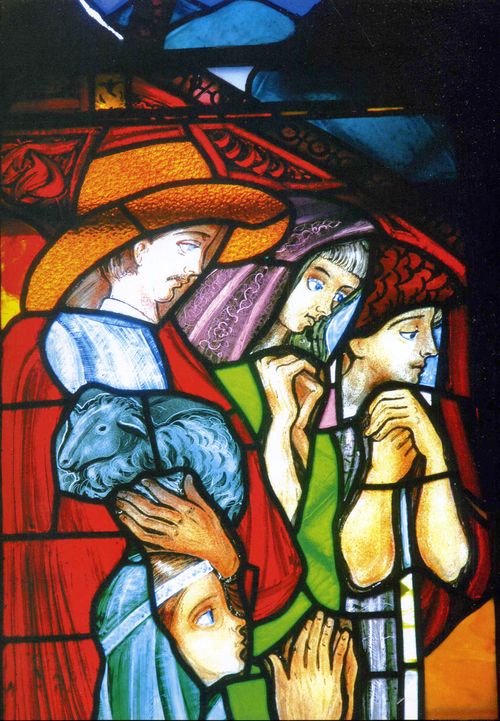Stained glass windows of Valerii Shalenko
Why the beauty has been replaced with utilitarian windows?
In June and July this year the National Taras Shevchenko Museum in Kaniv hosted the exhibition entitled “Around Taras” by Lviv muralist Valerii Shalenko. An act of tribute and respect to the poet and artist, illustrated with little-known, out-of-the-schoolbook events in his biography, opens the audience to another side of Shalenko’s creative talent, as a contemporary master of stained glass art.
The artist was born in the town of Sokal near Lviv on July 31, 1947. “Thus, I am a Galician,” writes Valerii in his biography. “My parents came to Lviv from Zhuky, near Poltava, immediately after the war. They were young and in love, and fled from the wrath of my grandmother, who did not approve of my mother’s choice (father, Stepan, was a mobilized soldier), so they gladly took the opportunity of moving to Halychyna, where my mother, Halyna, was routed as a young teacher. But soon they got familiar with the situation and returned to their home Zhuky...”
When Valerii was six, the family moved to Lubny. There he went to school. Picturesque landscapes of Mhar monastery, the floodplains of the Sula River, and Scythian kurgan stelae in the city center became a trigger for his interest in art. He trained in the art studio for young workers, led by artist and ethnographer Vasyl Semeniuta. His teacher had not only taught him the basics of painting, but also the love for discovery of old Cossack history, for studying of the past of this Russified region.
And then he entered Mykola Samokysh Simferopol Art College. However, the studies in the spirit of “socialist realism” had done little to attract the young artist and in 1966 he entered the Department of Glass Art at Lviv Institute of Applied and Decorative Arts. There he studied with such renowned teachers as Roman Selsky, Teofil Maksysko, Yakym Zapasko, Volodymyr Ovsiichuk.
Among Ukrainian cities, Lviv has preserved the largest number of stained glass windows, which decorate cathedrals and churches, public buildings and residential stone buildings of the city.
One should note the exceptional role of stained glass window in creating a special emotional and religious environment that fit a temple building. It is stained glass that provides sophisticated conversion of sunlight into the “ethereal light,” “beauty light.” Colored windows transform light into an infinitely variable substance, giving new qualities and unexpected light and color combinations to the internal temple space.
Mastering the art of stained glass, its light and colorful features, was decisive for creative experimentation of the young artist. In 1971 his passion took shape in the thesis project – stained glass Folk Art at the National Museum of Ukrainian art, on Drahomanov Street.
The beginning of the 1970s a circle of young poets and artists, united by a common love of books and talk about poetry, philosophy, and painting had formed in Ukraine – Hrytsko Chubai, Oleh Lysheha, Mykola Riabchuk, Viktor Morozov, Orest Yavorsky – like-minded friends who were miraculously spared by Brezhnev’s repressive machine of 1972. Shalenko took his place in this environment.
Realizing that restoration is not his vocation he fully dedicates himself to the art of stained glass. “We were several people who started the art of stained glass in Lviv in the 1970s,” remembers the artist. “I found it difficult and easy at the same time, we had no great tradition of Ukrainian stained glass, unlike the Poles, who had Mehoffer, unlike the Western Catholic tradition, so we had to start everything from scratch.”
In those years Valerii Shalenko made stained glass windows for Stepan Hzhytsky Lviv National University of Veterinary Medicine, National Bank, and the Intercity Bus Station in Lviv, the Ivan Franko museum in Nahuievychi and many others. “Unfortunately, many of my stained glass windows were destroyed,” bitterly recalls the artist, because “the beauty got replaced with utilitarian windows.”
In 1990s-2010s Shalenko created the stained glass compositions for St. Olha and Elizabeth Church at Kropyvnytsky Square, St. Andrew Church at Shevchenko Street, The Church of Our Lady of the Blessed Virgin Mary – Beholder of Ukraine on the Novoznesenska Street, and for the monastery of Sisters Servants of Mary Immaculate Congregation. Outside the city, he decorated temples in the villages of Vizhomlia and Kavske in Lviv oblast, Kabarivtsi in Ternopil oblast, Shevchenkove in Ivano-Frankivsk oblast.
Scene compositions depicting Jesus Christ, Virgin Mary, the apostles, saints, and martyrs of the Christian Church were created under the influence of Ukrainian iconography and include both the author’s interpretation and the psychological characteristics of the characters. “For these stained glass windows I solved the problems of color and shape, because stained glass for me is primarily glass, light, and graphics; the glass is what creates the painting,” says the artist.
For fifty years that he lived in Lviv, the artist has created a series of beautiful stained glass windows, which, like lead-frame glasses, each took place in the colorful composition of Lviv’s stained glass art of late 20th – early 21st centuries.
Newspaper output №:
№47, (2016)Section
Time Out





